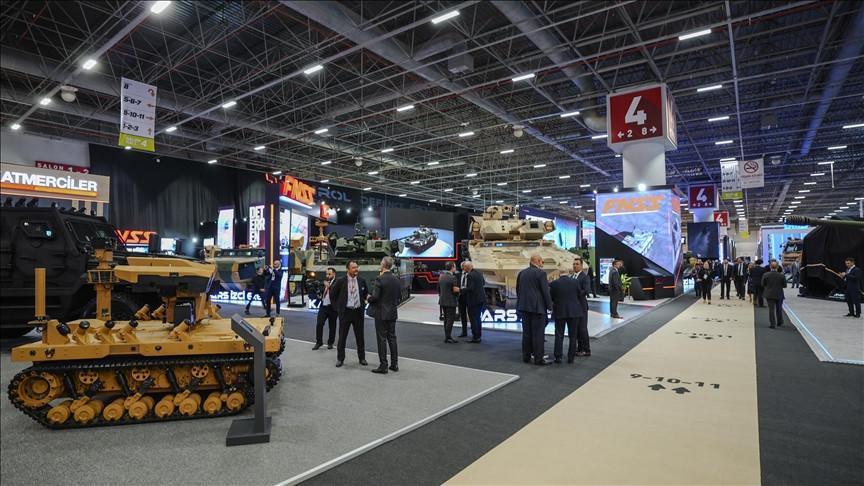
Türkiye's defense industry is on full display at the ongoing International Defense Industry Fair (IDEF 2025) in Istanbul, where local companies are unveiling cutting-edge systems amid strong global interest.
The event, which runs until July 27, features indigenous technologies aimed at boosting export potential and national security.
Defense Industries Agency President Haluk Görgün highlighted the fair's emphasis on high-quality innovations during his remarks to CNN Türk.
"The products here stand out not only in number but in their advanced capabilities," he said, pointing to exhibits like air-to-ground munitions, next-generation ballistic missiles, underwater torpedo systems and the Tayfun-4 hypersonic missile.
One standout is the "Steel Dome" air defense concept, making its debut. This AI-integrated system plays a key role in Türkiye's multi-layered air defense setup, coordinating radars, sensors, weapons, rockets and missiles to deliver the fastest and most effective responses to threats.
Aselsan is leading the fully domestic project.
Roketsan, a leader in missile and rocket technology, drew crowds with six new unveilings.
The AKATA, a capsule version of the ATMACA anti-ship missile, enables launches from submarines, placing Türkiye among a select few nations with underwater guided-missile prowess.
It boasts a range of over 250 kilometers and a high-explosive fragmentation warhead, strengthening maritime defenses.
GÖKBORA, a beyond-visual-range air-to-air missile, can be fired from manned or unmanned aircraft. With superior guidance and a range exceeding 100 nautical miles, it serves as a strong counter to aerial threats.
The TAYFUN Block-4 represents Türkiye's first hypersonic ballistic missile, also its longest-range homegrown model. Weighing more than 7 tons, it uses a multi-purpose warhead to target strategic sites such as air defense systems, command centers, hangars and key facilities from great distances.
EREN, a high-speed loitering munition, deploys from UAVs, helicopters, land vehicles, ground stations or naval platforms. It engages low-speed aerial targets, armored or unarmored ground assets and personnel, featuring advanced guidance, extended flight time and a range beyond 100 kilometers.
The 300 ER is an air-launched ballistic missile compatible with jets and UAVs, achieving ranges over 500 kilometers depending on release altitude and speed.
Powered by solid fuel, it provides rapid, high-precision strikes with customizable guidance options and warheads.
ŞİMŞEK-2, a satellite launch vehicle, aims to propel Türkiye further in space. It can place 1,500-kilogram satellites into sun-synchronous orbits above 700 kilometers.
Meanwhile, Sarsılmaz, Türkiye's top firearms producer, presented a range of domestically developed systems at the fair.
From its portfolio of over 300 products, Sarsılmaz spotlighted innovations from TR Mekatronik, its joint venture with Turkish Aerospace Industries (TUSAŞ), where each holds a 50 percent stake.
The company focuses on meeting medium-caliber weapon needs.
TR Mekatronik General Manager Fatih Çevik described the 20 mm nose gun for ATAK helicopters.
Integrated into the aircraft's front, the three-barreled system fires 20 mm ammunition at 750 rounds per minute. Mounted on a mobile turret, it handles elevation, depression and horizontal rotation through the helicopter's fire control.Çevik noted the gun's export success, already in active use abroad.
"We integrate the latest subcomponents for longer life and lower maintenance costs, giving us an edge in global markets over similar systems," he told state-run Anadolu Agency.
He also detailed the NATO-compliant 25 mm land gun, which supports dual feeding for two munition types, offering field flexibility. It fits remote-controlled or manned turrets and open naval setups.
In unmanned systems, LA2 Dynamics Engineering General Manager Aziz Karaş outlined Sarsılmaz's work on legged robots.
These four-legged mobile platforms, produced by LA2 under Sarsılmaz, extend remote weapon control into hazardous zones.
"You wouldn't risk lives in a cave operation or unknown area," Karaş said.
"These robots can enter, capture images, map in 3D and provide intel. For action, add explosives or weapons to engage threats."